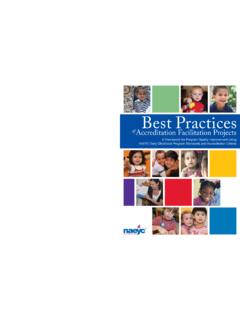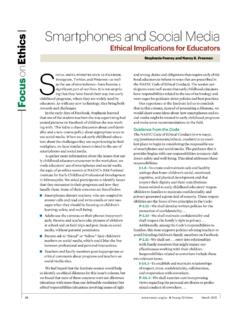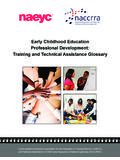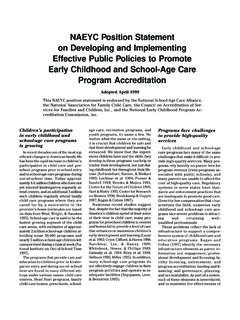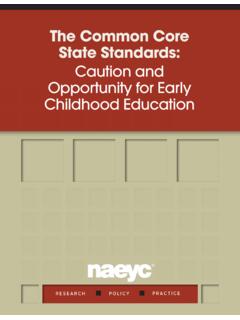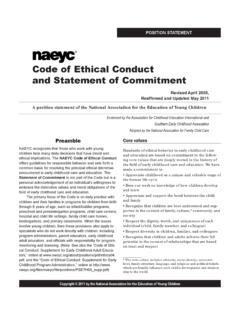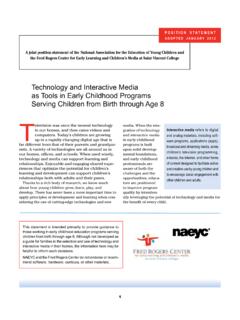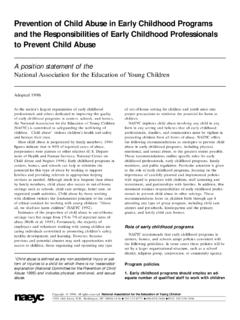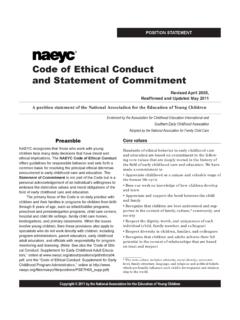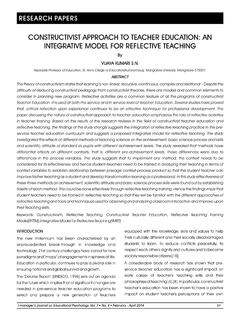Transcription of Early Childhood Mathematics: Promoting Good …
1 Copyright 2002 National Association for the Education of Young Children1 POSITION STATEMENTE arly Childhood mathematics : Promoting good BeginningsPositionThe National Council of Teachers of Mathemat-ics (NCTM) and the National Association for the Education of Young Children (NAEYC) affirm that high-quality, challenging, and accessible mathe-matics education for 3- to 6-year-old children is a vital foundation for future mathematics learning. In every Early Childhood setting, children should experience effective, research-based curriculum and teaching practices. Such high-quality class-room practice requires policies, organizational supports, and adequate resources that enable teachers to do this challenging and important challengesThroughout the Early years of life, children notice and explore mathematical dimensions of their world. They compare quantities, find patterns, navigate in space, and grapple with real problems such as balancing a tall block building or sharing a bowl of crackers fairly with a playmate.
2 Math-ematics helps children make sense of their world outside of school and helps them construct a solid foundation for success in school. In elemen-tary and middle school, children need mathemat-ical understanding and skills not only in math courses but also in science, social studies, and other subjects. In high school, students needmathematical proficiency to succeed in course work that provides a gateway to technological literacy and higher education [1 4]. Once out of school, all adults need a broad range of basic mathematical understanding to make informeddecisions in their jobs, households, communities, and civic lives. Besides ensuring a sound mathematical foundation for all members of our society, the nation also needs to prepare increasing numbers of young people for work that requires a higher proficiency level [5, 6]. The National Commissionon mathematics and Science Teaching for the 21st Century (known as the Glenn Commission) asks this question: As our children move toward the day when their decisions will be the ones shaping a new America, will they be equippedwith the mathematical and scientific tools needed to meet those challenges and capitalize on those opportunities?
3 [7, p. 6]A joint position statement of the National Association for the Education of Young Children (NAEYC) and the National Council of Teachers of mathematics (NCTM). Adopted in 2002. Updated in 2002 National Association for the Education of Young ChildrenEarly Childhood Mathematics2 Since the 1970s a series of assessments of students performance has revealed an over-all level of mathematical proficiency well below what is desired and needed [5, 8, 9]. In recent years NCTM and others have addressed thesechallenges with new standards and other re-sources to improve mathematics education, and progress has been made at the elementary and middle school levels especially in schools that have instituted reforms [ , 10 12]. Yet achieve-ment in mathematics and other areas varies widely from state to state [13] and from school district to school district. There are many en-couraging indicators of success but also areas of continuing concern.
4 In mathematics as inliteracy, children who live in poverty and who are members of linguistic and ethnic minority groups demonstrate significantly lower levels of achieve-ment [14 17]. If progress in improving the mathematics proficiency of Americans is to continue, much greater attention must be given to Early math-ematics experiences. Such increased awareness and effort recently have occurred with respect to Early foundations of literacy. Similarly, increased energy, time, and wide-scale commitment to the Early years will generate significant progress inmathematics learning. The opportunity is clear: Millions of young children are in child care or other Early educa-tion settings where they can have significant Early mathematical experiences. Accumulating research on children s capacities and learning in the first six years of life confirms that Early experiences have long-lasting outcomes [14, 18].
5 Although our knowledge is still far from com-plete, we now have a fuller picture of the math-ematics young children are able to acquire and the practices to promote their understanding. This knowledge, however, is not yet in the hands of most Early Childhood teachers in a form to ef-fectively guide their teaching. It is not surprising then that a great many Early Childhood programshave a considerable distance to go to achieve high-quality mathematics education for children age 3-6. In 2000, with the growing evidence that the Early years significantly affect mathematics learn-ing and attitudes, NCTM for the first time includ-ed the prekindergarten year in its Principles and Standards for School mathematics (PSSM) [19]. Guided by six overarching principles regarding equity, curriculum, teaching, learning, assess-ment, and technology PSSM describes for each mathematics content and process area what chil-dren should be able to do from prekindergarten through second Principles for School MathematicsEquity: Excellence in mathematics education requires equally high expectations and strong support for all : A curriculum is more than a col-lection of activities.
6 It must be coherent, focused on important mathematics , and well articulated across the : Effective mathematics teaching re-quires understanding of what students know and need to learn and then challenging and supporting them to learn it : Students must learn mathematics with understanding, actively building new knowledge from experience and prior : Assessment should support the learning of important mathematics and fur-nish useful information to both teachers and : Technology is essential to teach-ing and learning mathematics ; it influences the mathematics that is taught and enhances students : These principles are relevant across all grade levels, including Early Childhood . The present statement focuses on children over 3, in large part because the knowledge base on mathematical learning is more robust for this age group. Available evidence, however, Copyright 2002 National Association for the Education of Young ChildrenNAEYC/NCTM Joint Position Statement3indicates that children under 3 enjoy and benefit from various kinds of mathematical explorations and experiences.
7 With respect to mathematics education beyond age 6, the recommendations on classroom practice presented here remain relevant. Further, closely connecting curriculum and teaching for children age 3 6 with what is done with students over 6 is essential to achieve the seamless mathematics education that chil-dren need. Recognition of the importance of good begin-nings, shared by NCTM and NAEYC, underlies this joint position statement. The statement de-scribes what constitutes high-quality mathemat-ics education for children 3 6 and what is nec-essary to achieve such quality. To help achieve this goal, the position statement sets forth 10 research-based, essential recommendations to guide classroom1 practice, as well as four recom-mendations for policies, systems changes, and other actions needed to support these high-quality mathematics education for 3- to 6-year -old children, teachers and other key professionals should1.
8 Enhance children s natural interest in math-ematics and their disposition to use it to make sense of their physical and social worlds2. build on children s experience and knowl-edge, including their family, linguistic, cultural, and community backgrounds; their individual approaches to learning; and their informal-knowledge3. base mathematics curriculum and teaching practices on knowledge of young children s cognitive, linguistic, physical, and social- emotional development4. use curriculum and teaching practices that strengthen children s problem-solving and reasoning processes as well as representing, communicating, and connecting mathematical ideas5. ensure that the curriculum is coherent and compatible with known relationships and se-quences of important mathematical ideas6. provide for children s deep and sustained interaction with key mathematical ideas7. integrate mathematics with other activities and other activities with mathematics8.
9 Provide ample time, materials, and teacher support for children to engage in play, a context in which they explore and manipulate mathematical ideas with keen interest9. actively introduce mathematical concepts, methods, and language through a range of ap-propriate experiences and teaching strategies10. support children s learning by thoughtfully and continually assessing all children s math-ematical knowledge, skills, and support high quality mathematics edu-cation, institutions, program developers, and policy makers should1. create more effective Early Childhood teach-er preparation and continuing professional development2. use collaborative processes to develop well aligned systems of appropriate high-quality standards, curriculum, and assessment3. design institutional structures and policies that support teachers ongoing learning, team-work, and planning4. provide resources necessary to overcome the barriers to young children s mathematical proficiency at the classroom, community, insti-tutional, and system-wide Classroom refers to any group setting for 3- to 6-year-olds ( , child care program, family child care, preschool, or public school classroom).
10 Copyright 2002 National Association for the Education of Young ChildrenEarly Childhood Mathematics4 Recommendations Within the classroomTo achieve high-quality mathematics edu-cation for 3- to 6-year-old children, teach-ers2 and other key professionals should1. Enhance children s natural interest in mathematics and their disposition to use it to make sense of their physical and social children show a natural interest in and enjoyment of mathematics . Research evidence indicates that long before entering school chil-dren spontaneously explore and use mathemat-ics at least the intuitive beginnings and their mathematical knowledge can be quite complex and sophisticated [20]. In play and daily activi-ties, children often explore mathematical ideas and processes; for example, they sort and clas-sify, compare quantities, and notice shapes and patterns [21 27]. mathematics helps children make sense of the physical and social worlds around them, and children are naturally inclined to use math-ematics in this way ( He has more than I do!)
